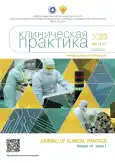Analysis of the results of the surgical treatment of plano-valgus foot deformity in children and adolescent
- Authors: Trankovskiy S.E.1,2, Protsko V.G.1,3, Akhpashev A.A.2
-
Affiliations:
- Federal Scientific and Clinical Center for Children and Adolescents of the Federal Medical and Biological Agency of Russia
- Academy of Postgraduate Education Federal Scientific and Clinical Center for Specialized Medical Assistance and Medical Technologies of the Federal Medical Biological Agency
- Peoples' Friendship University of Russia
- Issue: Vol 14, No 1 (2023)
- Pages: 77-83
- Section: Original Study Articles
- URL: https://journals.rcsi.science/clinpractice/article/view/142807
- DOI: https://doi.org/10.17816/clinpract110806
- ID: 142807
Cite item
Full Text
Abstract
Background: Plano-valgus deformity of the feet is a common reason for contacting an orthopedist. Pediatric orthopedics uses technologies, in particular, subtalar arthroeresis, that do not violate the physiological growth of the patient.
Aim: to choose the optimal methods for the correction of foot deformity in children and adolescents. Analysis of the results of the surgical treatment.
Methods: In the period from 2013 to 2022, 482 patients were operated on for flat-foot deformity. Subtalar arthroeresis surgery was performed in 405 cases in various combinations.
Results: The 9-year-long observation of the patients after the surgical treatment showed that in most cases there was a persistent positive effect, namely: no complaints of pain syndrome, no clinical and radiological pictures of a plano-valgus foot, patients led an active lifestyle, including sports. On average, after 17.7 months, 66 cases (16.1%) required replacement of the subtalar implant due to the physiological growth of patients. In 125 cases (31.2%) the implant was removed on average 31.2 months after placement. Unsatisfactory results were noted in 14 patients (3.4%).
Conclusions: The technique of subtalar arthroeresis, as a low-traumatic one, does not interfere with the physiological growth of the foot skeleton, does not limit physiological loads after the surgical treatment, and is actively used in the childhood and adolescence. The peculiarity of the subtalar arthroeresis in a patient with the physiological growth of the foot skeleton is a high probability of the subtalar implant replacement.
Full Text
##article.viewOnOriginalSite##About the authors
Sergey E. Trankovskiy
Federal Scientific and Clinical Center for Children and Adolescents of the Federal Medical and Biological Agency of Russia; Academy of Postgraduate Education Federal Scientific and Clinical Center for Specialized Medical Assistance and Medical Technologies of the Federal Medical Biological Agency
Author for correspondence.
Email: doctseort@yandex.ru
ORCID iD: 0000-0002-7118-8528
SPIN-code: 5017-4839
врач травматолог–ортопед отделения травматологии и ортопедии, сотрудник кафедры травматологии и ортопедии
Russian Federation, 20 Moskvorechye street, 115409 Moscow; MoscowVictor G. Protsko
Federal Scientific and Clinical Center for Children and Adolescents of the Federal Medical and Biological Agency of Russia; Peoples' Friendship University of Russia
Email: 89035586679@mail.ru
SPIN-code: 4628-7919
MD, PhD
Russian Federation, 20 Moskvorechye street, 115409 Moscow; MoscowAlexander A. Akhpashev
Academy of Postgraduate Education Federal Scientific and Clinical Center for Specialized Medical Assistance and Medical Technologies of the Federal Medical Biological Agency
Email: akhpashev@gmail.com
ORCID iD: 0000-0002-2938-5173
SPIN-code: 9965-1828
MD, PhD
Russian Federation, MoscowReferences
- Олейник А.В. Подтаранный артроэрез в лечении плосковальгусной деформации стоп у детей: Автореф. дис. … канд. мед. наук. Москва, 2019. 28 с. [Oleinik AV. Sub-rammed arthroeresis in the treatment of flat-foot deformity in children [dissertation abstract]. Moscow; 2019. 28 p. (In Russ).]
- Mosca VS. Calcaneal lengthening for valgusdeformity of the hind foot Results in children who had severe, symptomatic flatfoot and skewfoot. J Bone Joint Surg. 1995;77(4):500–512. doi: 10.2106/00004623-199504000-00002
- Лашковский В.В., Мармыш А.Г. Детская и подростковая педиатрия: современные подходы к диагностике и лечению заболеваний стоп // Новости хирургии. 2011. № 2. С. 94–100. [Lashkovsky VV, Marmysh AG. Pediatric and adolescent pediatrics: Modern approaches to the diagnosis and treatment of foot diseases. News of Surgery. 2011;(2):94–100. (In Russ).]
- Димитриева А.Ю. Мобильное плоскостопие у детей младшего школьного возраста: Автореф. дис. … канд. мед. наук. Санкт-Петербург, 2020. 34 с. [Dimitrieva AYu. Mobile flat feet in children of primary school age [dissertation abstract]. Moscow; 2020. 34 p. (In Russ).]
- Кенис В.М., Лапкин Ю.А., Хусаинов Р.Х., Сапоговский А.В. Мобильное плоскостопие у детей (обзор литературы) // Ортопедия, травматология и восстановительная хирургия детского возраста. 2014. № 2. С. 44–54. [Kenis VM, Lapkin YuA, Khusainov RH, Sapogovsky AV. Mobile flat feet in children (literature review). Pediatric Traumatology, Orthopaedics and Reconstructive Surgery. 2014;(2):44–54. (In Russ).]
- Шабалдин Н.А., Титов Ф.В., Гибадуллин Д.Г., Маликова Л.Г. Анализ результатов хирургического лечения ригидной плосковальгусной деформации стоп у детей методом подтаранного артроэреза // Политравма. 2019. № 1. С. 47–52. [Shabaldin NA, Titov FV, Gibadullin DG, Malikova LG. Analysis of the results of surgical treatment of rigid planovalgus deformity of the feet in children by the method of rammed arthroeresis. Polytrauma. 2019;(1):47–52. (In Russ).]
- Процко В.Г., Тамоев С.К., Загородний Н.В., и др. Анализ осложнений после подтаранного артроэреза у пациентов с плосковальгусной деформацией стоп // Травматология и ортопедия России. 2011. № 4. С. 37–43. [Protsko VG, Tamoev SK, Zagorodny NV, et al. Analysis of complications after a rammed arthroeresis in patients with flat-foot deformity. Traumatology and Orthopedics of Russia. 2011;(4):37–43. (In Russ).]
Supplementary files






